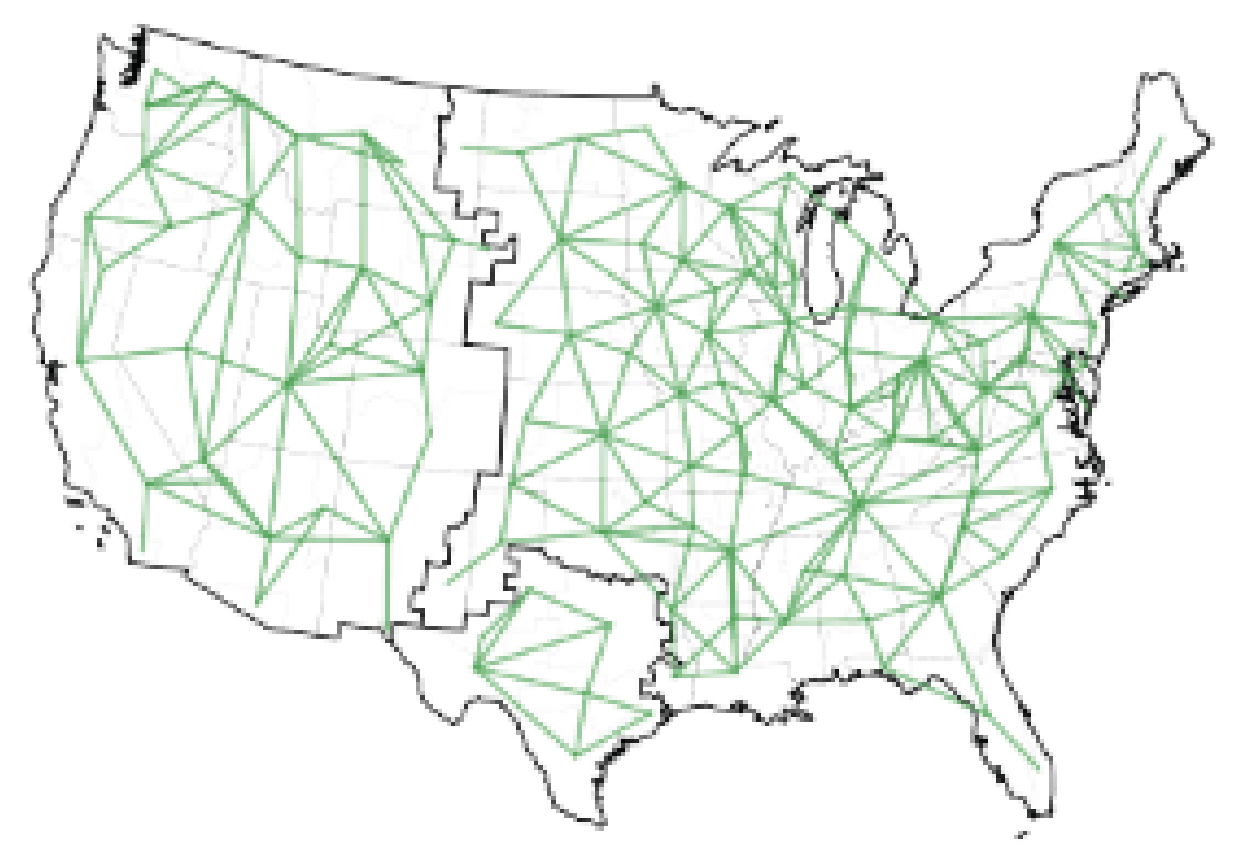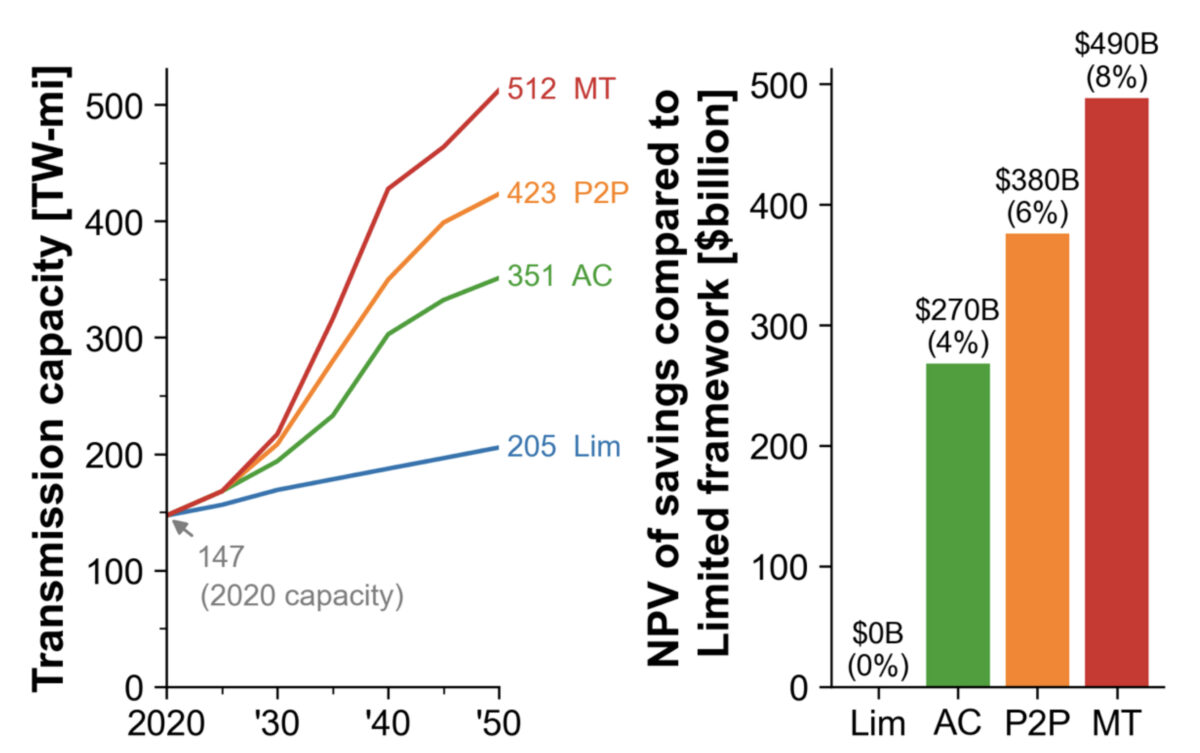The U.S. Department of Energy has released its National Transmission Planning Study.
The study considers four transmission frameworks and highlights the increasing levels of savings across the frameworks under a high-renewables grid.
DOE analyzed the four frameworks to compare how the optimal electricity system—including generation, storage, and transmission—might evolve with different constraints and opportunities for transmission.
DOE first considered a “Limited” transmission framework, effectively “business as usual,” that allowed transmission expansion not exceeding the recent annual maximum amount, and no transmission across the multiple grid regions shown in the nearby image.

DOE then compared that baseline to three accelerated transmission frameworks.
The “Alternating Current” framework allowed transmission extending within each of the Eastern, Western and Texas interconnections.

The “Point-to-Point” framework allowed transmission nationwide, without boundaries, plus long-distance point-to-point HVDC transmission.

The “Multiterminal” framework includes HVDC with advanced multiterminal converters, and appears similar to a proposed “macrogrid” framework proposed by grid modeling firm Vibrant Clean Energy in 2022. VCE’s framework evaluated underground HVDC, plus underwater HVDC along the East, West and Gulf coasts largely to transmit offshore wind power. DOE did not include offshore HVDC.

As shown in the image from DOE’s report at the top of this story, when evaluating 90% emissions reductions for the nation’s grid by 2035, transmission capacity by 2050 could increase from 205 terawatt-miles under the Limited framework to as much as 512 terawatt-miles under the Multiterminal framework.
The same image shows that net savings through 2050 could reach as high as $490 billion under the Multiterminal framework, compared to the Limited framework. DOE said that “approximately $1.60 to $1.80 is saved for every dollar spent on transmission.”
Putting those savings in context, DOE said that the Limited framework would have total system costs of $6.37 trillion by 2050, so that the savings from added transmission would range from 4% to 8% of total system costs.
In a separate but similarly-named National Transmission Needs Study, DOE found last year that the U.S. will need to add 54.5 TW-miles of within-region transmission by 2035 under future scenarios with moderate load but high clean energy assumptions. The regions referenced in that study are those shown for the Limited framework above.
DOE’s transmission planning study also projects the optimal capacity of utility-scale solar and land-based wind in each state by 2035 for each of the four frameworks, under the study’s central assumptions of mid-demand growth and 90% emissions reductions by 2035.
In some states the optimal capacity of utility-scale solar is higher in the frameworks with HVDC than under the Alternating Current framework. But in other states the utility-scale solar capacity is higher in the Alternating Current framework, apparently because for those states HVDC transmission would allow for more imported solar power and less in-state solar power.
Previous solar and wind capacity projections from the National Renewable Energy Laboratory’s Interconnection Seams Study showed that HVDC could economically transmit solar power from sunnier regions to less sunny regions, but that adding HVDC transmission would not result in more solar overall. Rather, it could lead to more solar development in sunnier regions but less solar development in other regions, leaving the total approximately unchanged.
DOE previously shared preliminary results from the national transmission planning study suggesting that to cost-effectively reach a high level of renewable generation, additional transmission will be needed to connect the wind belt in the central U.S. to eastern grids.
VCE projected in its least-cost macrogrid scenario that installed solar capacity would exceed 830 GW by 2050 and wind capacity would exceed 1130 GW, with onshore wind predominating.
DOE found a higher level of estimated net savings under high demand growth scenarios, ranging from $710-970 billion through 2050, and said that “coupling high demand with more rapid decarbonization can yield more than $1 trillion in savings.”
Overall, DOE evaluated 96 scenarios across the four transmission frameworks.
The study did not consider “in detail” the best technology to increase transmission capacity between regions, such as reconductoring or the use of grid enhancing technologies.
Nor did the study evaluate how increased levels of distributed resources, demand flexibility or energy efficiency would change the optimal amounts of transmission or utility-scale resources.
DOE will present a webinar on the study on October 16.
This content is protected by copyright and may not be reused. If you want to cooperate with us and would like to reuse some of our content, please contact: editors@pv-magazine.com.








By submitting this form you agree to pv magazine using your data for the purposes of publishing your comment.
Your personal data will only be disclosed or otherwise transmitted to third parties for the purposes of spam filtering or if this is necessary for technical maintenance of the website. Any other transfer to third parties will not take place unless this is justified on the basis of applicable data protection regulations or if pv magazine is legally obliged to do so.
You may revoke this consent at any time with effect for the future, in which case your personal data will be deleted immediately. Otherwise, your data will be deleted if pv magazine has processed your request or the purpose of data storage is fulfilled.
Further information on data privacy can be found in our Data Protection Policy.